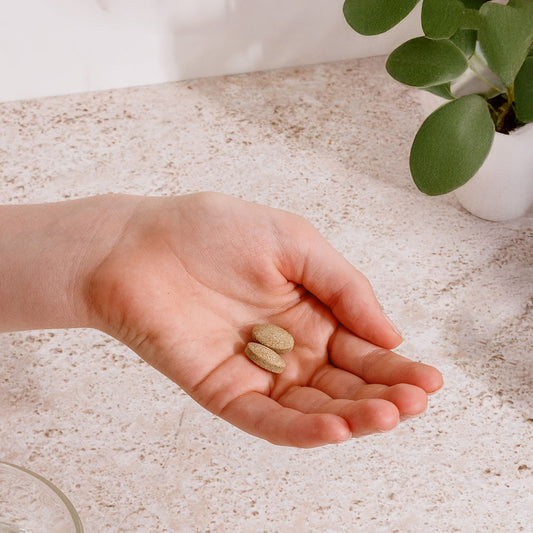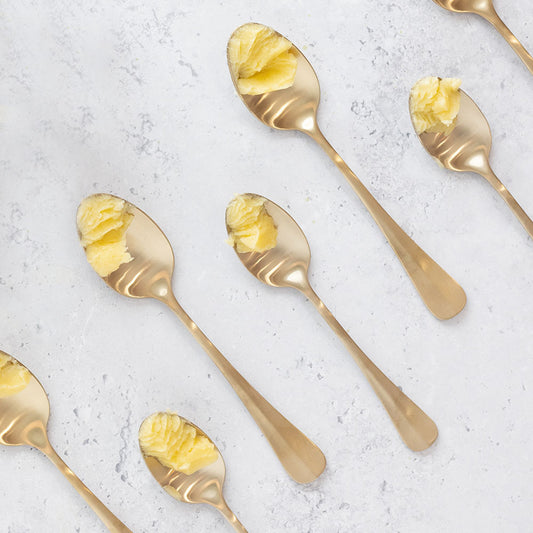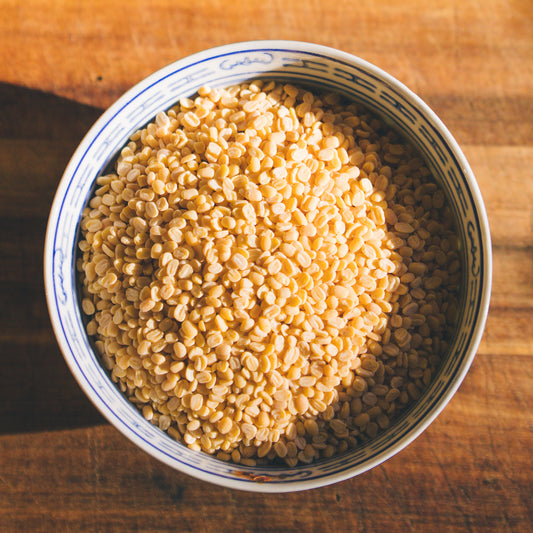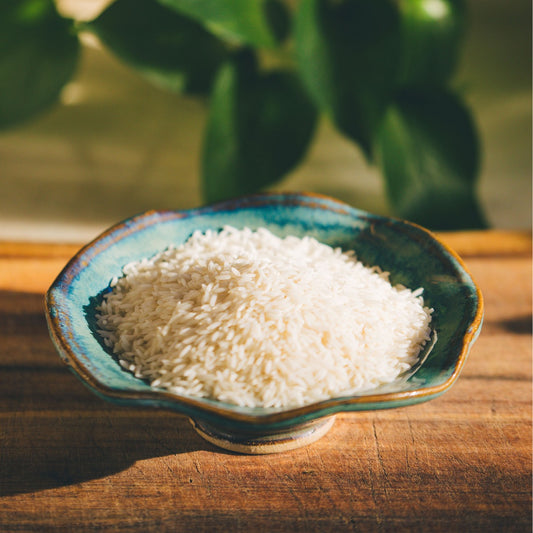Pitta-Balancing Diet
If you've been told you should focus on balancing
Pitta is balanced by a diet of fresh, whole foods (both cooked and raw) that are cooling, hearty, energizing, comparatively dry, and high in carbohydrates.
These foods calm pitta by decreasing internal heat, balancing the digestive fire, grounding the body, and by absorbing excess liquid and oil. Because pitta is relatively substantive in nature, an appropriate diet is actually a very effective way to support a return to balance.
What follows are some specific principles that we hope will empower you in discovering a pitta-balancing diet that will work for you.
Embrace Slow, Steady, and Small Shifts
Before you read any further, please understand that following a pitta-balancing diet is a practice far more than it is a collection of absolutes. No one expects you to wake up tomorrow morning and eat a perfectly pitta-balancing diet for the rest of your life!
Even the most recognized
The point being, successfully following a pitta-balancing diet is not a matter of sticking to a strict set of dos and don'ts, or getting overly bogged down in the details. In fact, it is often far more helpful to pay attention to the generalities and overarching patterns.
At the end of the day, any strides that you take to shift your diet toward being more pitta-balancing than it is today should be considered wins.
Think of the process as an intention that you are holding, and also a powerful invitation to increase your self-awareness. We recommend that you begin by noticing where you might be able to make small, incremental changes in support of your healing journey—at a sustainable pace.
From there, notice the ways in which these small shifts are supporting you, and where perhaps some of your current habits are costing you.
If you enjoy a food that is pitta-aggravating, notice how you feel when you do eat it.
Does it increase the presence of pitta symptoms in your digestive tract (heat, burning sensations, or loose stools)? Is there anything that you can do to serve this food in a more pitta-balancing manner—by reducing the quantity and by adding some cooling herbs and spices (like cilantro, coriander, cumin, fennel, or mint), lime juice, avocado, or coconut? And if so, do these adjustments change your digestive experience?
Use your developing awareness to continue to inspire one small step forward at a time, keeping tabs on how your health and well-being are improving over time.
As you continue to work with your Ayurvedic diet and lifestyle recommendations, it is likely that your digestive strength will improve, which will eventually support your capacity to handle more challenging foods with ease.
Qualities to Favor
Ok. Now that we're on the same page about how to approach this, we'd like to introduce the qualities that you'll want to favor in your diet, and by contrast, the qualities that will tend to be inherently pitta-aggravating.
By nature, pitta is oily, sharp, hot, light, spreading, and liquid, so eating foods that neutralize these qualities—foods that are dry, mild, cooling, grounding, stabilizing, and dense—can help to balance excess pitta.
This section offers a closer look at how you can begin to recognize the qualities of different foods. The intention is to give you a more intuitive grasp of what will reduce pitta, without having to constantly reference lengthy lists of foods to favor and avoid.
Favor Cool over Warm or Hot
The cool quality can be emphasized by eating foods that are cool in temperature or that have a cooling energetic—and by using cooling spices generously.
Most spices are heating in nature, so pay careful attention to the ones that balance pitta, such as CCF Spice Mix. (You'll also find a comprehensive list in our resource on Pitta-Balancing Foods).
Raw foods tend to be naturally cooling, and pitta tends to be able to handle them better than the other
On the other hand, it is best to minimize your exposure to fiery hot dishes, foods with a sharply warming energetic, alcohol, and caffeine; all of these influences will naturally increase internal heat.
Favor Dense, Grounding, and Nourishing Over Light
While the heavy quality is the true antithesis to pitta's lightness,
Generally, these foods will naturally taste sweet. Most grains, milk, root vegetables, seeds, and cooling oils are good examples. But excess pitta can cause a sharp and sometimes insatiable appetite, so it's equally important not to overeat.
Highly processed foods such as canned foods, ready-made meals, and pastries often lack
Favor Dry and Dense Over Oily or Liquid
Pitta's liquid nature and tendency toward excess oil make drying or astringent foods like beans, potatoes, oats, pasta, popcorn, and most vegetables very supportive.
When cooking, use a moderate amount of a high quality oil or ghee. Minimize especially heating oily foods like eggs (egg whites are better), hard cheeses, olives, nuts, sour cream, and the like.
If given a choice between a soupy, liquidy meal and one that is denser and drier, opt for the latter. For example, have baked tofu served over steamed greens and rice, rather than tofu miso soup.
Favor Mild over Sharp
Sharp flavors like pineapple, pickles, vinegar, and sharp aged cheeses are better replaced with milder, gentler tastes, like those found in apples, cucumbers, lime juice, and soft cheeses.
Similarly, stimulants such as caffeine, nicotine, and hard alcohol are too sharp and penetrating for pitta. Do your best to substitute more stable and sustaining sources of energy.

Tastes to Favor and Avoid
Pitta is pacified by the sweet, bitter, and astringent tastes and aggravated by the pungent, sour, and salty tastes. Understanding these tastes allows us to make better choices whether or not we have an extensive list of Pitta-Balancing Foods handy.
Emphasize
Sweet
- Favor naturally sweet foods like sweet fruits, most grains, squashes, root vegetables, milk, ghee, and fresh yogurt.
- The sweet taste is cooling and heavy. It pacifies heat, satisfies thirst, benefits the skin and hair, and tends to be grounding, nourishing, strength building, and satisfying.
- Emphasizing the sweet taste does NOT require us to eat large amounts of refined sugar or sugary sweet foods; naturally sweet foods are best.
Bitter
- The bitter taste predominates bitter greens—like kale, dandelion greens, and collard greens. It is also found in bitter melon, Jerusalem artichokes, dark chocolate, and pitta balancing spices like cumin, neem leaves, saffron, and turmeric.
- The bitter taste is exceptionally cooling, but also drying.
- Bitters cleanse the palate and improve the sense of taste. They tone the skin and muscles, benefit the blood, relieve burning and itching sensations, satisfy thirst, balance the appetite, support digestion, and help to absorb moisture, sweat, and excess pitta.
Astringent
- The astringent taste is basically a flavor of dryness—a chalky taste that dries the mouth and may cause it to contract (picture biting into a very green banana).
- Legumes—adzuki beans, black-eyed peas, chickpeas, kidney beans, lentils, pinto beans, soybeans, and so forth—are classically astringent in taste. Some fruits, vegetables, grains, baked goods, and spices are also astringent in taste—things like apples, cranberries, pomegranate, artichokes, broccoli, cauliflower, lettuce, popcorn, rice cakes, crackers, basil, coriander, dill, fennel, parsley, and turmeric.
- The astringent taste is heavy, cold, and dry.
- Pitta benefits from the compressing, absorbing, union-promoting nature of the astringent taste. It can curb pitta's tendency to spread, tone bodily tissues, prevent bleeding disorders, thwart diarrhea, and also absorb excess sweat and fluid.
Minimize
Pungent
- Pungent is a spicy, hot flavor like that found in chilies, radishes, turnips, raw onions, and many especially heating spices.
- The pungent taste is particularly hot and light—both qualities that disturb pitta.
- Too much pungent taste can cause excess thirst, burning sensations, dizziness, and excess heat (especially in the intestinal tract).
Sour
- Minimize sour foods like vinegar and other fermented foods, hard cheeses, sour cream, green grapes, pineapple, grapefruit, and alcohol (an occasional beer or white wine is often ok).
- Pitta is aggravated by the hot, light, and oily qualities of the sour taste.
- Too much sour taste can increase thirst, disturb the blood, create heat in the muscles, and give rise to burning sensations in the throat, chest, or heart. It can even promote sour feelings like jealousy or envy.
- An occasional squeeze of cooling lime juice as a garnish is the best way for pitta to include the sour taste.
Salty
- The salty taste is almost singularly derived from salt itself.
- Much like the sour taste, it is salt's light, hot, and oily nature that aggravates pitta.
- The salty taste can disturb the blood's balance, impede the sense organs, increase heat, aggravate the skin, and lead to grey hair, wrinkles, and excess thirst. It can also intensify our desire for stronger flavors, which can provoke pitta even further.
How to Eat
When it comes to balancing pitta, how we eat is surprisingly important, so this is an especially useful place to focus if the prospect of radically changing your diet feels overwhelming right now.
As most people with pitta digestion know, pitta's sharp appetite can lead to a general intolerance for skipping meals. For this reason, pitta does well to stick to a regular eating schedule and to eat at least three square meals each day. Eating at consistent times from one day to the next also helps to balance an overactive digestive fire.
As often as possible, it is important to eat in a peaceful environment and to give your full attention to the act of being nourished so that your body registers satisfaction. This will help to prevent overeating, which is a common side effect of pitta's voracious appetite.
Hot, spicy foods, extremely sour foods, and overly salted foods are especially pitta-provoking. And as we have already discussed, the aggravating potential of many pitta-aggravating foods can be minimized by making sure they are taken in small quantities and served with cooling garnishes (like cilantro, coriander, cumin, fennel, mint, avocado, and coconut).
Lastly, if you feel the need to do a cleanse, a short fruit or juice fast (think apple or pomegranate), or a longer monodiet of kitchari can be very supportive.
Does Tea Increase Pitta Dosha?
For our warm beverage loving friends out there, you may be wondering if hot drinks like coffee and tea increase pitta dosha. The answer—it depends!
As mentioned above, it's generally best to favor foods and drinks that are cooler in temperature. This is especially true during the hot summer season, when our internal heat is already elevated by the natural envirionment.
But that certainly doesn't mean that you can't enjoy refreshing cool drinks and iced teas, such as this summertime hibiscus cooler.
In the cooler months, you can get away with drinking more warm beverages, especially if they are made with cooling and soothing pitta-friendly herbs. For example, a warm cup of Joyful Heart, Mellow Mind, or even creamy Turmeric Milk Mix will be balancing and satisfying for pitta.
Typically, it's best to avoid coffee and black tea as they can aggravate pitta. That said, an occasional cup with a splash of milk and a good dose of awareness may be okay.
Suggested Meals
Breakfast
Breakfast is usually not to be skipped when pitta is elevated. Workable choices are sweet, high in carbohydrates, and yet offer sustained energy. Consider:
- A hearty fruit salad (apples, pears, red grapes, and blueberries) garnished with raisins and shredded coconut. This lighter meal will probably work better in the warmer months than in the dead of winter.
- A yummy breakfast can be as simple as a date and almond shake made from soaked dates, soaked and peeled almonds, and boiled milk (or a substitute)—blended together with cardamom and a pinch of cinnamon.
- Oatmeal or rice porridge made with hot milk and garnished with raisins or chopped dates, chopped almonds (soaked and peeled), ghee, and maple syrup.
- An egg white and vegetable omelet, served with avocado and whole grain toast.
Lunch
Ideally, lunch is the main meal of the day, meaning it's the largest and the most nourishing. A wide variety of appropriate grains, beans, and vegetables are great building blocks for lunch, and can be complimented with suitable meats, if you eat them. Try something like:
- Seasoned tofu and steamed collard greens over wild rice. Sauté the tofu in sunflower oil and stir in some of your favorite pitta balancing spices. Garnish the greens with olive oil, freshly squeezed lime juice, ground coriander, and black pepper.
- Red lentils made with cooling herbs like cilantro, mint, or fennel, with buttered whole grain bread (use unsalted butter), sautéed purple cabbage, and a green salad. Add vegetables like carrots, celery, and onion to your soup. Sauté the cabbage in ghee with cumin, coriander, turmeric, lime juice, and a splash of maple syrup.
-
Avocado fried riceand sprouted wheat bread with
- Whole wheat pasta, pesto, and fresh vegetables (like bell peppers, broccoli, carrots, celery, green beans, mushrooms, zucchini, or black olives). Garnish the pasta with crumbled chèvre, olive oil, and cilantro. Serve with a small green salad and soup.
Dinner
Dinner is ideally a bit smaller and lighter than lunch, but it also needs to sustain pitta's active metabolism. A simple but nourishing meal or a slightly smaller serving of lunch can work well. Try:
- Green mung beans with dill, paired with roasted asparagus and basmati rice.
- Veggie (or turkey) burgers with sautéed mushrooms, goat cheese, lettuce, avocado, and a side of home fries.
- Spiced double rice, omitting the mustard seeds and replacing the cashews with soaked and peeled almonds, pumpkin seeds, or sunflower seeds, and served with flatbread.
Specific Pitta-Balancing Foods
To view a detailed list of foods to favor and minimize when pacifying pitta, please see our resource on Pitta-Balancing Foods—remembering of course, that this list is meant to help you deepen your understanding and begin to see overarching patterns—not to create a sense of restriction or deprivation.
If food lists tend to have that effect on you, focus on the qualitative guidelines above instead. Embrace eating regularly and being fully present with your meals. That is as good a starting place as any.
More for You
Pitta and the Six Tastes
Pitta is primarily composed of the fire and water elements, which make pitta light, sharp, hot, oily, liquid, spreading, and subtle. Because of these characteristics, pitta is balanced by the sweet, bitter, and astringent tastes and aggravated by the sour, salty, and pungent tastes.
Cleansing Excess Pitta from the Body
Excess pitta can become reactive, settle in the tissues, and manifest as an imbalance if it overstays its welcome. Learn how to calm and soothe this dosha for balance.










